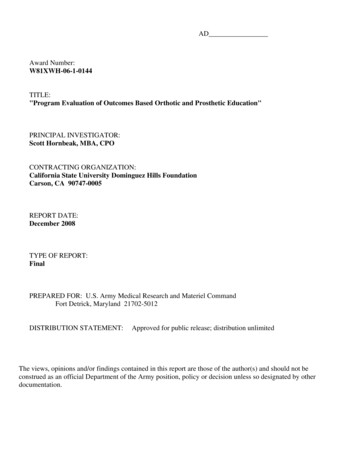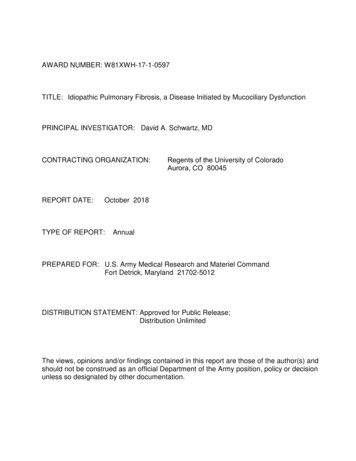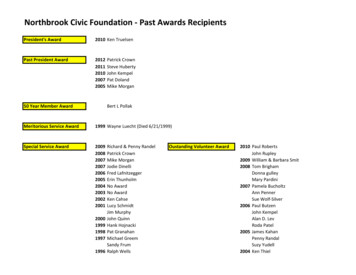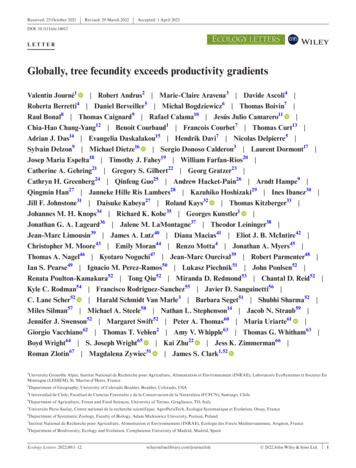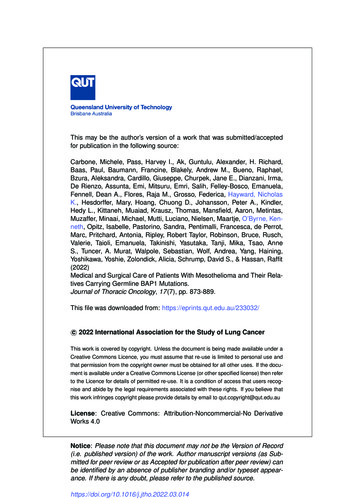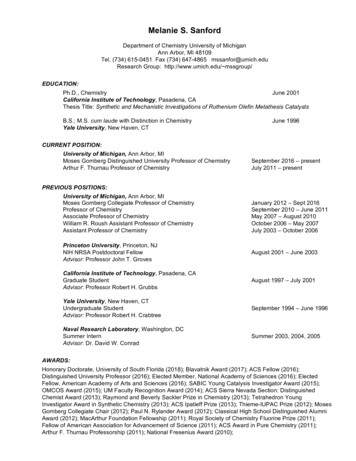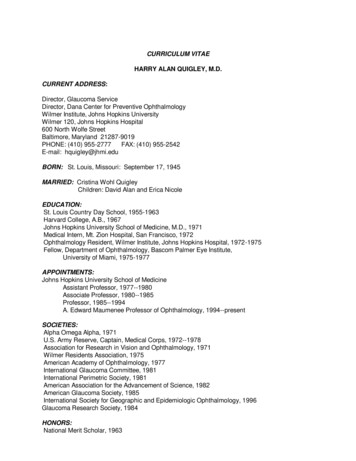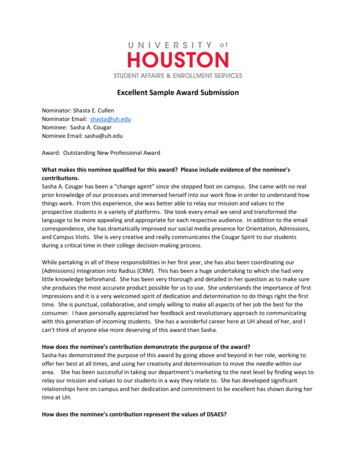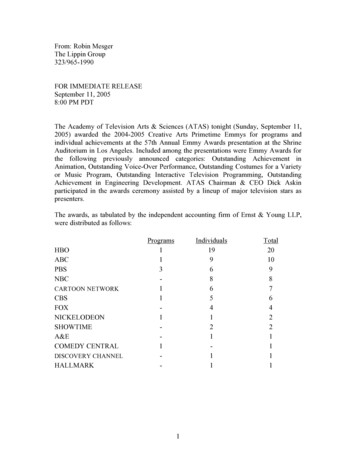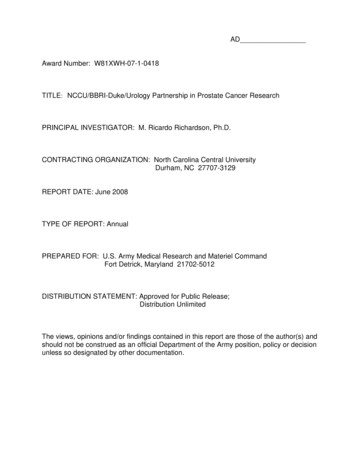
Transcription
ADAward Number: W81XWH-07-1-0418TITLE: NCCU/BBRI-Duke/Urology Partnership in Prostate Cancer ResearchPRINCIPAL INVESTIGATOR: M. Ricardo Richardson, Ph.D.CONTRACTING ORGANIZATION: North Carolina Central UniversityDurham, NC 27707-3129REPORT DATE: June 2008TYPE OF REPORT: AnnualPREPARED FOR: U.S. Army Medical Research and Materiel CommandFort Detrick, Maryland 21702-5012DISTRIBUTION STATEMENT: Approved for Public Release;Distribution UnlimitedThe views, opinions and/or findings contained in this report are those of the author(s) andshould not be construed as an official Department of the Army position, policy or decisionunless so designated by other documentation.
Form ApprovedOMB No. 0704-0188REPORT DOCUMENTATION PAGEPublic reporting burden for this collection of information is estimated to average 1 hour per response, including the time for reviewing instructions, searching existing data sources, gathering and maintaining thedata needed, and completing and reviewing this collection of information. Send comments regarding this burden estimate or any other aspect of this collection of information, including suggestions for reducingthis burden to Department of Defense, Washington Headquarters Services, Directorate for Information Operations and Reports (0704-0188), 1215 Jefferson Davis Highway, Suite 1204, Arlington, VA 222024302. Respondents should be aware that notwithstanding any other provision of law, no person shall be subject to any penalty for failing to comply with a collection of information if it does not display a currentlyvalid OMB control number. PLEASE DO NOT RETURN YOUR FORM TO THE ABOVE ADDRESS.1. REPORT DATE2. REPORT TYPE3. DATES COVEREDAnnual01-06-200818 May 2007 – 17 May 20084. TITLE AND SUBTITLE5a. CONTRACT NUMBERNCCU/BBRI-Duke/Urology Partnership in Prostate Cancer Research5b. GRANT NUMBERW81XWH-07-1-04185c. PROGRAM ELEMENT NUMBER6. AUTHOR(S)M. Ricardo Richardson, Ph.D.; Judd Moul, M.D.; Delores Grant, Steve Freedland,M.D.; Catherine Hoyo, Ph.D.; Xiaoxin Chen, Somnath Muhopadhyay, Ph.D.; JoellenSchildkraut, Ph.D.; David Tulis, Ph.D.; Leon Sun, Ph.D.; Lee Jones, Ph.D.; PhillipFebbo, Ph.D.E-Mail: mrrichardson@nccu.edu7. PERFORMING ORGANIZATION NAME(S) AND ADDRESS(ES)5d. PROJECT NUMBER5e. TASK NUMBER5f. WORK UNIT NUMBER8. PERFORMING ORGANIZATION REPORTNUMBERNorth Carolina Central UniversityDurham, NC 27707-31299. SPONSORING / MONITORING AGENCY NAME(S) AND ADDRESS(ES)10. SPONSOR/MONITOR’S ACRONYM(S)U.S. Army Medical Research and Materiel CommandFort Detrick, Maryland 21702-501211. SPONSOR/MONITOR’S REPORTNUMBER(S)12. DISTRIBUTION / AVAILABILITY STATEMENTApproved for Public Release; Distribution Unlimited13. SUPPLEMENTARY NOTES14. ABSTRACTThe NCCU/BBRI-Duke/Urology Partnership in Prostate Cancer Research was developed to promote Collaborative Training, Research, andCommunity Dialogue and Outreach among scientists from NCCU and Duke. During the first funding period, NCCU scientists, with theexpertise of their Duke partners, have started five collaborative pilot projects. These projects have provided needed training for NCCUscientists in the development and approval of IRB protocols for research involving human subjects, and access to key core facilities andlibraries at Duke. Some reagents important to the success of the projects have been developed including a mouse model of prostate cancerdeficient in arrestin 2 (TRAMP- arr2-/-) or 5-Lox (TRAMP-Alox5-/). Several prostate cancer cell lines have also been adapted to theprincipal investigators laboratories for in vitro studies. Our collaboration has also led to the submission of three grant proposals: one to theUSAMRMC and two to the National Institute of Health. The USARMC proposal entitled: “Association of the UGT2B17 Gene DeletionPolymorphism and the Incidence of Ovarian Cancer and Ethnicity” and the Export project entitled “Roles of Inflammation and AndrogenMetabolism in Prostate Cancer Disparity” have been funded. The U54 application in partnership with UNC-Lineberger and DukeComprehensive Cancer Centers entitled “NCCU-DCCC-LCCC Partnership In Cancer Research” is under revision.15. SUBJECT TERMSProstate Cancer16. SECURITY CLASSIFICATION OF:a. REPORTUb. ABSTRACTU17. LIMITATIONOF ABSTRACT18. NUMBEROF PAGESc. THIS PAGEU19a. NAME OF RESPONSIBLE PERSONUSAMRMC19b. TELEPHONE NUMBER (include areaUU19code)
Table of ContentsPageIntroduction . . . 1Body . 2Key Research Accomplishments . . 13Reportable Outcomes 14Conclusion 14References . 14Appendices 158.7.2007
Introduction:Prostate cancer is the most common cancer in men resulting in the loss of 30,000 lives per year inthe United States. An estimated 218,890 new cases were diagnosed in 2007 (1, 2). AfricanAmericans are more likely to develop prostate cancer than any other racial or ethnic groups.Although the survival rates for cancer has improved, for people of African descent, survival ratesfor prostate cancer and other cancers are dismally worse compared to Caucasians. AfricanAmericans still have higher risk and poorer clinical outcomes than any other ethnic groups (3).Could it be possible the poorer health outcomes for African Americans and other minority groupsresult from their lack of representation in scientific research? Since it is well recognized thatminorities are more likely to trust and cooperate with minority scientists in their community toaddress minority related health issues, building a diverse pool of scientists and clinicalinvestigators is critical to reduce health disparities. The long-term goal of the NCCU/BBRIDuke/Urology Partnership is to develop innovative approaches for prevention, detection, andtreatment of prostate cancer, through research, training and collaboration between these twoinstitutions. Community outreach through one of the leading Historically Black Colleges andUniversities (HBCU) in this country will eventually help address the issue of health disparity inDurham and the surrounding area of North Carolina, where there is a large population of AfricanAmericans.Body:Task #1: Create the Prostate Cancer Disparity Research and Training Center (PCDRT) anddevelop plan for training.a) We have created the Collaborative Prostate Center and developed a plan for Training,Research, and Community Dialogue and Outreach and established our programadvisory committee. Our first meeting was held at the JLC-BBRI and was attended by thePrincipal Investigators and the research teams from both Duke and NCCU.b) Ms. Sacajawea Gray replaced Ms. Romelia Perez as Administrative Assistant for theCancer Research Program. A Program Steering Committee meeting was held in theauditorium of the JLC-Biomedical Biotechnology Research Institute of NCCU on May 22,2008. The Principal Investigators (PI) and Co-PI presented the hypotheses and aims oftheir project followed by a discussion.c) The cancer group met weekly (Mondays at 9 a.m.) to discuss the projects and relevantmanuscripts in prostate cancer. Bi-weekly meeting were also conducted at the Duke/VAwith our Duke collaborators to discuss samples accrual, IRB approval and other issues. Inaddition, the group has a monthly progress report meeting, held the last Monday of eachmonth, in which data from a project is presented to the rest of the group, followed by adiscussion.d) Scientists from NCCU have attended the Duke Symposium in Prostate Cancer held inFebruary 2008 at the Duke Comprehensive Cancer Center.e) Drs. Richardson, Chen and Grant in collaboration with our Duke Collaborators wrote a fullproposal entitled: “Roles of Inflammation and Androgen Metabolism in Prostate CancerDisparity” that submitted in our EXPORT center grant. This proposal has been funded byNational Center on Minority Health and Health Disparity (NCMHD). Dr. Grant and Dr.8.7.2007
Schildkraut teamed up to write a training proposal for Dr. Grant entitled: “Association ofthe UGT2B17 Gene Deletion Polymorphism and the Incidence of Ovarian Cancer andEthnicity”. This proposal has been funded by the USAMRMC and works have alreadybegan. In collaboration with our partners at Duke Comprehensive Cancer Center (DCCC)and UNC Lineberger Comprehensive Cancer Center (LCCC) we have submitted a U54grant application (U54CA137837) to the National Cancer Institute entitled “NCCU-DCCCLCCC Partnership in Cancer Research”. This three-way partnership has a combinedbudget of 14.9 million dollars.Task #2: Develop a core facility for the Collection of clinical samples and data.a) Ms. Kelly Anderson has been recruited in February 2008 as a Research Associate to assistthe Duke team in the collection of clinical samples.b) The NCCU team of investigators led by Dr. Grant and the Duke investigators by Dr.Freeland meet weekly at the Duke VA to discuss the training of Ms. Anderson, themodifications of the IRB protocol and questionnaire, and the logistics concerning the futureaccrual and distribution of samples when the final IRB is approved. The ResearchAssociate was supposed to be at Duke 50% of the time and, as a consequence, 50%salary support was requested in the original proposal. The task, however, requires Ms.Anderson to be on site 100% of the time. We have requested a revised budget to reflectthis need.c-e) Subject recruitment, data collection of enrolled patients, processing and distribution ofsamples to NCCU scientists are awaiting final IRB approval from the DOD.Task #3: Develop 5 pilot studies focusing in the molecular, genetic socio-cultural aspectsof prostate cancer incidence and disparities.a) A NCCU approved IACUC protocol was submitted to the Department of Defense. Thisprotocol includes several mouse strains including the TRAMP model that is beingcrossbred with the β-arrestin 2 knockout to generate the TRAMP-βarr2-/- model.b) The research team of NCCU/BBRI scientists in collaboration with scientists and cliniciansfrom Duke/Urology Department has developed a Collaborative Research Center in ProstateCancer to promote independent, competitive research and training programs. Fiveindependent studies focusing on the molecular, genetic and socio-cultural aspects ofprostate cancer disparities were developed. Below is the progress of each project alongwith the significance and future directions.8.7.2007
Pilot Project #1: The UGT2B Gene Polymorphisms and its Association with ProstateCancer DisparityInvestigator: Delores Grant, Ph.D. NCCUCollaborators: Cathrine Hoyo, PhD, Stephen Freedland, MD, Joellen Schildkraut, PhD,Philip Febbo, MD, Duke/UrologyA. Specific Aims1) Determine whether there is an association between the UGT2B17 deletion and UGT2B15D85Ygenotype in genomic DNA samples and prostate cancer risk using a case control study inAfrican and Caucasian populations2) Compare expression levels of the UGT2B17 gene in RNA samples from the prostate cancercases and controls and determine whether these also vary by race;3) Quantitate serum glucuronides of testosterone and testosterone metabolites among controls todetermine association with 0, 1, or 2 copies of UGT2B17 and;4) Compare expression levels of the UGT2B17 gene in prostate cancer tissue and normal marginsutilizing tissue microdissection and immunohistochemistryB. Studies and ResultsIn the direction of accomplishing these Aims we have designed a hospital based case controlstudy. Participants will be recruited from the Veterans Administration Medical Center (VAMC) inDurham, including the number of subjects (cases and controls) that can be accrued form thefacility, given patient volume. We have identified inclusion and exclusion criteria. In addition, wehave recruited and trained a research assistant, Ms. Kelly Anderson, in collecting peripheralblood, administering the 10-page questionnaire, entering data into an electronic data base, andpreparing accrual reports. In preparation for starting the study, the research assistant has beentrained to amend Duke and the VA Institutional Review Board (IRB) to the ongoing case-controlstudy to ensure that the Specific Aims are met. Because investigators on the study are Dukeemployees and data are collected from the VAMC, preparing IRB requests for approval haveinvolved preparing three separate requests; one for the VAMC, a separate IRB request for DukeUniversity and a third for the United States Army Medical Research and Material Command’s(USAMRMC) Office of Research Protection (ORP), Human Research Protection Office (HRPO).We are currently addressing changes outlined in the Protocol Addendum to Dr. StephenFreedland’s “A Comparative Study of Risk Factors for Men with and without Prostate Cancer”,HRPO Log Number A-14291.1 and the Memorandum for Record (MCMR-ZB-PH (70-1n1)). Wehave previously submitted amendments to Dr. Freedland’s protocol in March 2008 which requiredfurther changes. This has ultimately delayed the start of our study. We plan to begin accrual in thenext three months.C. SignificanceSuccessfully addressing the Aims outlined above will enhance our knowledge of prostate cancerby identifying a combination of biomarkers that could be used in conjunction with the PSA toimprove our prediction of aggressive vs. non-aggressive prostate cancer at the early stage.Questionnaire data together with specimens collected using this funding will provide a resource forNCCU to explore additional hypotheses at a future date, thus enable additional studies to befunded.D. PlansDuring the next funding cycle after approval from ORP and HRPO we will begin to recruit subjectsfor this study. An amended protocol will be submitted to ORP and HRPO by June 20, 2008. We8.7.2007
have recruited an NCCU Master of Science graduate student, Ms. Tiffany Anderson, who willbe trained and co-mentored by Drs. Freedland, Hoyo, and Grant during the next cycle. We willalso conduct laboratory and statistical analyses using data collected. If findings are promising, wewill apply for additional funding to investigate this hypothesis in more samples.E. PublicationsNo publicationsF. Project-Generated ResourcesSamples and questionnaire data will be generated and kept as a common resource for NCCUfaculty. No other resources were generatedPilot Project #2: Role of β-arrestins in prostate cancer development and its contribution toProstate Cancer DisparityInvestigator: M. Ricardo Richardson, PhD. NCCU/BBRI.Collaborators: Judd Moul, M.D., Duke/UrologyA. Specific Aims1) To determine whether the level of expression of βarr-1 and/or βarr-2 are elevated in prostatictissues from African American Men (AAM) relative to Caucasians American men (CAM).2) To develop the TRAMP mouse model of prostate cancer in mice deficient in either βarr-1 orβarr-2B. Studies and Results1. Our studies using both RT-PCR (Fig 1-A) andWestern blotting (Fig 1-B) have shown thatexpression of βarr-1, but not βarr-2, is markedlyincreased in prostatic cell lines from both AAM(E006AA) and CAM (PC3) compared to controlprostate cell lines (RWPE1 and RWPE2). With ourcollaborators at Duke/VA an IRB has beendeveloped and is currently being revised to besubmitted to the USARM for final approval. We arewaiting for the final approval of the IRB to startaccruing prostatic tissue samples from AAM andCAM at the Duke VA hospital with different, levelof tumor aggressiveness. These samples will beused to further confirm these results anddetermine whether overexpression of βarr-1 isassociated with tumor aggressively2. Consistent with our plan, we have alsogenerated a mouse model of prostatecancer deficient in βarr-2. To that end,theTransgenicAdenocarcinoma(TRAMP) mouse model (C57BL/6 strain)was crossbred with βarr2-/- model that isalso of C57BL/6 strain (Fig 2A). MaleTRAMPmiceuniformlyandspontaneously develop autochthonous8.7.2007Figure 1. β-arrestin Expression in Prostate Cancercells. A) Relative quantification of β-arrestin mRNAexpression levels in prostate cell lines. Quantities ofβ-arrestin 1 and 2 mRNA levels were determined ineach sample using the relative quantification method ofreal-time PCR. Messenger RNA level of β-arrestin wasmeasured in each sample relative to levels expressed inHEK-293 cells and normalized to the measured valuesof endogenous levels of ribosomal RNA 18s. Valuesrepresent means SEM.B) Expression level of β-arrestin 1/2 in prostatecells. Western blot analysis was performed to measurethe expression level of β-arrestin 1/2 in prostate celllines. Cells were lysed in RIPA buffer, and a total of20 g of protein for each lane was loaded onto an SDSpolyacrylamide gel. The membrane was blotted againstβ-arrestin 1/2 antibody.Figure 2: A) Schematic representation of coss-breeding of TRAMP-/positive C57BL/6 mice with βarr2 animals. F1 generation was-/-/backcrossed with βarr-2 to obtain the TRAMP-βarr2 strain. B)Genotyping results of mice from F2 generation. #14 is a representative-/of a TRAMP-βarr2 mouse.
prostate tumor following the onset of puberty. Male TRAMP-βarr2-/- (Fig 2B, animal #14)along with control TRAMP is being followed for the development of prostate tumor that usuallyoccur between 25 to 40 weeks. Thus far, up to 30 weeks, no significant difference in tumorsize has been observed between the two groups. We are currently waiting for the finalapproval of our ACURO protocol to breed the TRAMP-βarr2-/- mice with βarr2-/- knockout forfurther experiment.C. SignificanceThis project is specifically designed to address one significant issue in health disparity of prostatecancer, why African American men have a higher risk of developing prostate cancer and poorerclinical outcome than Caucasian American men.D. Plans1. To continue the cell line experiments and determine whether expression of βarrestin-2 correlatewith tumor aggressiveness.2. To obtain IRB approval and collect prostatic tissues from human subjects.3. To correlate the in vitro data with tumor growth and metastasis in vivo using the TRAMP-βarr2-/mouse model.E. Human Subjects: Protocol under revisionF. Vertebrate Animals: No changeG. Publication:NAPilot Project #3: Role of 5-Lipoxygenase in Clinical Outcome of African American andCaucasian Prostate Cancer PatientsInvestigator: Xiaoxin Chen, MD, PhD. NCCU/BBRI.Collaborator: Leon Sun, MD, Duke/UrologyA. Specific Aims1) To determine whether expression and regulation of Alox5 and blt1 by promoter methylationand polymorphism may contribute to prostate cancer disparity between African American andCaucasian menB. Studies and Results1. We have performed immunohistochemical staining of 5-lipoxygenase (5-Lox) on paraffinsections of 150 cases of African American prostate cancer and 150 cases of CaucasianAmerican prostate cancer. Histopathological analysis is still ongoing. We plan to semi-quantifythe staining intensity and compare samples of African Americans and Caucasian Americans.The purpose is to find out whether there is any significance difference in the expression of 5Lox between African American and Caucasian American prostate cancer.2. Using two human prostate cancer cell lines (LNCaP, PC3) and two human normal prostateepithelial cell lines (PrEC1 and PrEC2), we examined the effect of 5-aza-2’-deoxycytidine (aDNA demethylating agent) on the expression of 5-Lox and BLT1. We have not yet reached asolid conclusion regarding the potential role of promoter methylation in regulating expressionof these two genes. Further improvement of our methodology is still in process.8.7.2007
3. We examined expression of 5-Lox in the prostate tissues of wild-type mice and TRAMPmice. Significant overexpression of 5-Lox was observed in the mouse prostate tumor ascompared with wild-type tissue. We have started to cross TRAMP mice with Alox5 knockoutmice to produce Alox5-/- TRAMP mice. The purpose is to determine whether knockout ofAlox5 may reduce tumorigenesis in TRAMP mice.Figure 1. Histopathology of prostate tissues of wild-type and TRAMPmice.A. anterior lobe of the prostate of the wild-type miceB. Lateral lobe of the prostate of a wild-type miceC. PIN lesion in the prostate of a TRAMP miceD. Well-differentiated prostate cancer of a TRAMP miceFigure 2. Expression of 5-Lox in prostate tissues of wildtype and TRAMP mice.A, B, C: 5-Lox expression in the prostate tissues of wildtype miceD, E, F: 5-Lox expression in the prostatetissues of TRAMP mice.C. SignificanceThis project is specifically designed to address one significant issue in health disparity ofprostate cancer, why African American men have a higher risk of developing prostate cancer andpoorer clinical outcome than Caucasian American men.D. PlansTo continue to work on the histopathological analysis of African American and CaucasianAmerican prostate cancer samples.1. To improve our current methods of methylation analysis.2. To breed Alox5-/- TRAMP miceE. Human Subjects: protocol under revisionF. Vertebrate Animals: No changeG. Publication: NoPilot Project #4: Anandamide-mediated Regulation of Prostate Cancer Cell Proliferationand Angiogenesis in African AmericansInvestigator: Somnath Mukhopadhyay, PhD, NCCU/BBRICollaborator: Judd Moul, MD, Duke/UrologyA. Specific Aims8.7.2007
1) To define the role of CB1 and CB2 cannabinoid receptors in endocannabinoidmethanandamide-mediated cell proliferation and androgenreceptor expression in EA006AA African American prostatecancer cells.2) Characterization of anandamide-mediated regulation of MMPactivity in E006AA prostate cancer cells.B. Studies and Results1. Using both, RT-PCR and Western blotting we have shown(Fig.1)that in African American prostate cancer cell line(E006AA) the level of CB2 receptor (CB2R) expression ishigher than normal prostate epithelial cells (PrEC).Fig. 1. Western Blot analysis of CB2Rexpression in PrEC and E006AA celllysate (30 μg)ControlJWH133JWH133 SR144528 (1μM)125Cell Proliferation(% Control)2. We then investigated the effect of CB2 receptor (CB2R)activation on E006AA cell proliferation (Fig.2). It wasfound that CB2 receptor agonist JWH 133 treatment for24 hours did not produced any significant changes in cellproliferation of E006AA cells but significantly decreasedcell proliferation at 48 hours in a dose-dependentmanner. We also found that CB2R antagonist(SR144528) attenuated JWH133-induced decrease inE006AA cell 10μMJWH133Fig.2. Effect of CB2R activation on E006AAcell proliferationControlSR144528 (1μM)JWH133JWH133 SR144528 (1μM)3. We have also determined that CB2 receptor activationdid not alter cell viability of E006AA cells at 24 hours. Weare now testing the effect of longer exposure of CB2receptor agonist JWH 133 on E006AA cell viability. Wewill next determine the effect of CB2 receptor activationon androgen receptor expression.Next, we will investigate the effect other CB2 receptor agonists(JWH015, CP55940 and methanandamide) on E006AA cellproliferation and cell viability. We will also determine the relativepotency and efficacy of CB2 receptor agonists on E006AA cellproliferation and viability.Cell Migration(% of 3. Cell migration was assessed bymodified Boyden Chamber assay. Effect ofCB2R agonist in the presence or absenceof CB2R antagonist was expressed (mean sem from 3 separate experiments withsimilar results) with respect to control (%control).4. Consistent with our hypothesis, it was found that CB2 receptor activation significantlydecreased cell migration in E006AA cells (Fig.3). We have also determined that CB2Rantagonist SR144528 blocked JWH133-induced cell migration in E006AA cellsIn coming years we will continue to investigate molecular mechanism of this response in relationto focal adhesion kinase and matrix metalloprotease activity in E006AA cells.C. SignificanceThis project is addressing an important issue in health disparity of prostate cancer and resultsfrom this study will be helpful to understand the mechanism of the regulation of prostate cancergrowth and metastasis in African American men population. Thus the outcome of this project hasa direct therapeutic potential in terms of identifying novel drug target in the regulation of prostatecancer in African-American patients.8.7.2007
D.Plans1. To obtain a detailed pharmacological characterization of CB2 receptor-mediated regulationof E006AA cells. We will determine pharmacological efficacy of CB2 receptor agonist in theE006AA African American prostate cancer cell proliferation and viability.2. We will determine the effect of CB2 receptor activation on cell migration and metastasisusing in vitro cell culture model.3. We will also determine the molecular signaling mechanism of CB2 receptor-mediatedregulation of FAK and MMP activity in relation to cell migration and metastasis.E. Human Subjects: Not applicableF. Vertebrate Animals: Not applicable changeG. Publication: NoPilot Project #5: Feasibility of Endurance Exercise Training on Cardiovascular Risk FactorsFollowing Radical Prostatectomy among Men with Localized Prostate Cancer: ACommunity-Based InterventionInvestigators: Dave Tulis Ph.D., NCCU/BBRICollaborators: Catherine Hoyo, PhD; Lee Jones, PhD; Stephen Freeland, MD,Duke/UrologyA. Specific Aims1) To determine the effects of home-based endurance exercise training on exercise capacityfollowing radical prostatectomy among with men with localized prostate cancer.2) To assess the changes in other markers of CVD (i.e., lipid profile, blood pressure, fastinginsulin, C-reactive protein, and weight status).3) To explore the potential differential effects of exercise training between white and blackAmerican prostate cancer patients on specific aims 1 and 2.B. Studies and ResultsThe following section describes the research accomplishments achieved to date associated witheach tasks outlined in the approved statement of work.1. Prepare questionnaire for exercise trainingA comprehensive questionnaire was developed to assess the lifestyle and psychosocialdeterminants of exercise in prostate cancer patients (Appendix #1). This questionnaire wasdeveloped following an extensive literature review of pertinent work. Given that we areassessing the effects on endurance exercise training using a home-based exercise trainingprogram, it is critically important to assess the potential facilitators and barriers to exercise inthis setting. Such information is critical to inform the design of future studies to maximizestudy adherence and intervention efficacy as well as minimize study attrition.2. Gain Human Ethnical ApprovalAt Duke University Medical Center, there is a two-tiered system to obtain ethical approval toconduct clinical investigations among individuals diagnosed with cancer. Prior to submission8.7.2007
to the Institutional Regulatory Board (IRB), all clinical protocols have to be submitted andapproved by the Duke Comprehensive Cancer Center (DCCC) Cancer Protocol Committee(CPC). Attainment of human ethical approval for the present investigation was a long andcomplex process. We initially submitted all materials for IRB approval on August 10th, 2007.We gained CPC approval on October 5th, 2007. We applied for full IRB review on October 8th,2007 and finally received approved on February 27th, 2008. Based on the date of full studyexecution and our ‘statement of work’, full human ethical approval was anticipated by August1, 2007. However, full approval was not obtained until February 27th, 2008, 7 months behindschedule.3. Recruitment of PatientsSince gaining IRB approval we have, unfortunately, experienced further delays. Dr. Oates (thePostdoctoral Fellow at NCCU working with the researchers at Duke) has left the programwhich has significantly affected our ability to recruit patients and proceed with this study.Nevertheless, we are currently actively attempting to resolve this issue and are confident thatwe will able to proceed with patient recruitment in a timely fashion.1.2.3.4.C.Plans:Establish an immediate plan to initiate with subject recruitmentProceed with study proceduresAnalyze and interpret dataSubmit publicationD. Publication: NoTask #4: Training Determine the effects of home-based endurance exercise training onexercise capacity following radical prostatectomy among with men with localized prostatecancer.a) A questionnaire for exercise training has been generated. (see Appendix #1)b) The IRB protocol has been approved in February 27, 2008.c) As mentioned early, since gaining IRB approval, Dr. Oates the Postdoctoral Fellow atNCCU working with the researchers at Duke has left the program to accept a facultyposition at Tennessee State University (TSU). In addition, Dr. David Tulis (NCCU PI) whowas working on the exercise project with Dr. Lee Jones (Duke PI), has recently accepted aposition at East Carolina State University (ECU). Since the funds are not enough to hire anew postdoctoral fellow or to support a new faculty, we are working with the Duke team tomodify this project.Key Research Accomplishments:-We have created the Collaborative Prostate Center and Develop Plan for Training, Research,and Community Dialogue and Outreach and have established a program advisorycommittee.-We have hired and trained a Research Associate, Ms. Kelly Anderson.8.7.2007
-Dr. Grant and Dr. Schildkraut teamed up to write a successful training proposal for Dr. Grantentitled: “Association of the UGT2B17 Gene Deletion Polymorphism and the Incidence ofOvarian Cancer and Ethnicity”.-Drs. Richardson, Chen and Grant in collaboration with our Duke partners wrote a successfulproposal entitled: “Roles of Inflammation and Androgen Metabolism in Prostate CancerDisparity” that was submitted in our EXPORT center grant.-In collaboration with our partners at Duke Comprehensive Cancer Center (DCCC) and UNCLineberger Comprehensive Cancer Center (LCCC) we have submitted a U54 grant application(U54CA137837) to the National Cancer Institute entitled “NCCU-DCCC-LCCC Partnership inCancer Research”.Reportable Outcomes:1- Develop a
PRINCIPAL INVESTIGATOR: M. Ricardo Richardson, Ph.D. CONTRACTING ORGANIZATION: North Carolina Central University Durham, NC 27707-3129 REPORT DATE: June 2008 TYPE OF REPORT: Annual . Comprehensive Cancer Centers entitled "NCCU-DCCC-LCCC Partnership In Cancer Research" is under revision. 15. SUBJECT TERMS Prostate Cancer 16. SECURITY .
